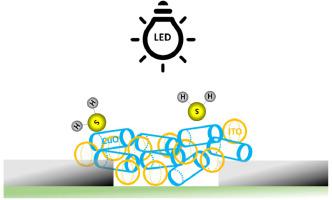Sensors and Actuators Reports Pub Date : 2024-01-03 , DOI: 10.1016/j.snr.2024.100185 Suporna Paul , Emily Resendiz Mendoza , Dung Thi Hanh To , Thien Toan Tran , Thomas Stahovich , Jennifer Schaefer , Nosang V. Myung

|
Various copper oxide nanotube/indium tin oxide (CuO/ITO) nanocomposite-based chemiresistive gas sensors were fabricated and tested toward hydrogen sulfide (H2S) in the presence and absence of ultra-violet (UV) light excitation at room temperature. Among these different combinations, 60:40 wt.% of CuO:ITO showed the highest sensing performance toward H2S gas (i.e., sensor response (S) = 5.7 toward 40 ppmm (parts per million by mass) H2S gas), which is ̴5.7 times higher than pristine CuO and ITO counterparts. The enhancement in the gas sensing performance by mixing ITO and CuO nanostructures might be due to the formation of p/n heterojunction between ITO nanoparticles and CuO nanotubes. The low limit of detection (LLOD) of 500 ppbm (part per billion by mass) of S = 1.2 was experimentally achieved by photo exciting sensing materials using 400 nm UV light. This might be attributed to the faster adsorption of H2S molecules and higher carrier concentration under light illumination. These sensors also maintained good H2S sensing performance in the presence of water vapors which makes these sensors suitable for practical application. This work paves a way to fabricate low-power H2S gas sensors by eliminating heaters.
中文翻译:

利用氧化铜纳米管/氧化铟锡纳米颗粒异质结检测室温硫化氢气体
制备了各种基于氧化铜纳米管/氧化铟锡(CuO/ITO)纳米复合材料的化学电阻式气体传感器,并在室温下在存在和不存在紫外(UV)光激发的情况下对硫化氢(H 2 S)进行了测试。在这些不同的组合中,60:40 wt.% 的 CuO:ITO 对 H 2 S 气体表现出最高的传感性能(即,对于 40 ppm m(质量百万分之几)的 H 2 S 气体,传感器响应 ( S) = 5.7 ),比原始 CuO 和 ITO 同类产品高 5.7 倍。通过混合 ITO 和 CuO 纳米结构来增强气体传感性能可能是由于 ITO 纳米颗粒和 CuO 纳米管之间形成了 p/n 异质结。 通过使用 400 nm 紫外光的光激发传感材料,实验性地实现了S = 1.2 的 500 ppb m(质量分之一)的检测下限 (LLOD) 。这可能归因于光照射下H 2 S分子的更快吸附和更高的载流子浓度。这些传感器在水蒸气存在的情况下也保持良好的H 2 S传感性能,这使得这些传感器适合实际应用。这项工作为通过消除加热器来制造低功率 H 2 S 气体传感器铺平了道路。



























 京公网安备 11010802027423号
京公网安备 11010802027423号